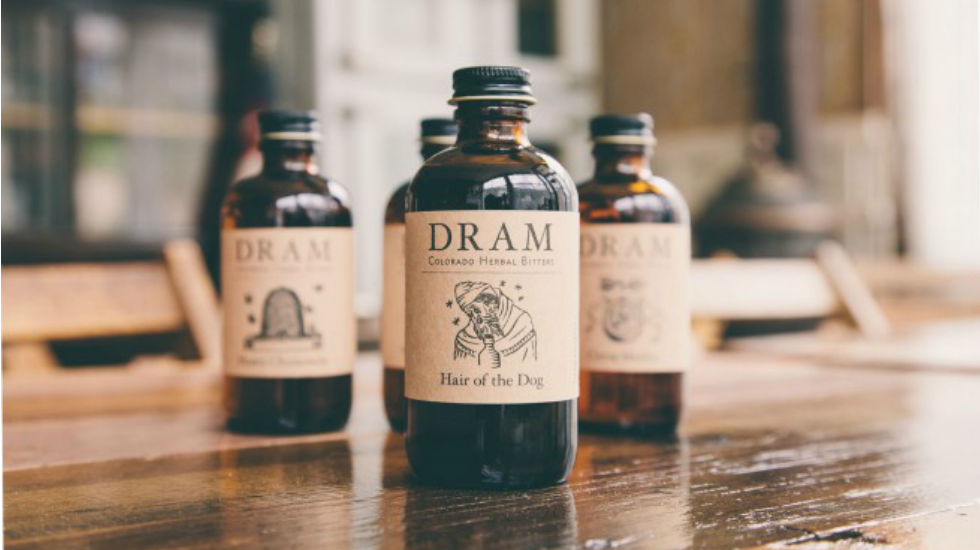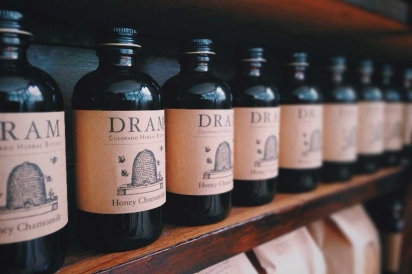Bitters-Sweet! DRAM Apothecary Breathes New Life into Colorado Ghost Town
Having established themselves at the epicenter of craft brewing, Coloradans set out a few years ago to tackle the next logical frontier: distilling. Today, there are over 50 producers of spirits in the state, and a growing number of mixologists dedicated to raising the bar on the noble art of building a drink. For years, though, two main ingredients have been missing from this mix: high-quality bitters and women. Both the craft spirit world and the nascent-but-booming craft bitters industry remain largely male dominated.
Shae Whitney, of DRAM Apothecary, is poised to change all that. DRAM is located in the extraordinarily sleepy ghost town of Silver Plume, 151 miles east of Aspen just off I-70. There, in a former 19th century building that once housed a saloon, Whitney and her life/business partner, Brady Becker, handcraft all of their products.
Popular bitters blends include Hair of the Dog, Whitney’s fennel-forward version of Angostura bitters and Black, made with Boulder-sourced walnuts that give the concoction its name and color. DRAM’s pine syrup is heavenly as well. Switchels (vinegar-and-honey-based concoctions popular in Colonial times as restoratives) and sodas (ginger switchel, and herbal pine) are recent additions to the line.
After launching DRAM in Denver in 2011, Whitney and Becker relocated to Silver Plume. “Driving back from skiing Vail for the millionth time, when this building was still a bakery, we were just perplexed that the town still existed,” says Whitney. “It’s considered a ‘living ghost town’ because it contains two-thirds of its original structures. We both strongly support the repopulation of rural and mountain areas, as it’s essential for their local economy and community to continue to exist. There are also a lot of great people here. Not counting seasonal railroad and ski employees, there are about 160 full-time residents. We finally made an offer on the bakery, and remodeled it entirely by ourselves. We had to remove 12 truckloads of trash first!”
Here, at 9,100 feet, surrounded by mostly decrepit Victorian homes and mining shacks, you’re more likely to run into a mine shaft than a suspender-wearing bartender. That’s just the way Whitney likes it. “I wanted DRAM to be accessible,” she says. “You don’t need to be a mixologist to make a great drink using our bitters. We try to stay in that realm of, ‘We’re not better than you.’ We just want people to enjoy using our products, without being intimidated by it.”
Although Whitney didn’t set out to market to women, DRAM’s online customers are 80 percent female, which she says is unique in the cocktail industry. Whitney’s retro style and ethos surely draws women—DRAM’s website and Instagram feed feature stunning, homespun, photography, recipes and styling done by the couple. Whitney may also be the only woman producing bitters in the U.S., and just five years into business she’s a female entrepreneur to be reckoned with: DRAM’s products are sold nationwide, with 120 wholesale accounts and a substantial waitlist.
The bitter truth
The exploding popularity of bitters in recent years has paralleled the transformation of humble bartenders into “mixologists” who cherish the complexity and balance bitters lend to their cocktails. It’s now commonplace to see flavors like rhubarb, celery, black walnut, or blood orange bitters behind the bar, whether they’re made in-house or purchased from an ever-growing supply of mid-and small-scale producers like Fee Brothers, Cocktail Punk, Bittermen’s, The Bitter Truth or Urban Moonshine.
Yet despite the sudden ubiquity of bitters in hip bars from San Francisco to Brooklyn, few consumers understand their medicinal history. As the name implies, they’re high-proof alcohol-based elixirs made from botanicals with a predominantly bitter taste. Bitter flavors have long been equated with poisonous plants, but many bitter botanicals also possess alkaloids and volatile compounds that have been used medicinally for thousands of years to treat everything from gastrointestinal upsets to coughs and arthritis. (Ancient Egyptians even made an early version of bitters with wine).
Anyone who’s worked in the restaurant business and suffered a hangover knows that the time-honored cure is a dash of bitters in soda water. Says Whitney, herself a former bartender, “The first place I worked, the Mexican dishwashers would drink a concoction of soda water, the juice of half a lime, and a teaspoon of bitters. It did the trick.”
It’s no mystery why bitters settle the stomach. Explains Whitney, “The compounds in certain plants trigger a sensory response in the mouth, which then causes the gut, pancreas, and liver to produce digestive enzymes. That’s why bitter digestifs [think Unicum, Aperol, or Fernet] are enjoyed the world over following a meal.” The most common botanicals used in bitters include gentian root, dandelion leaf, ginger, clove, wormwood, fennel and citrus peel. Other ingredients like turmeric have proven benefits as anti-inflammatories, while juniper and sage are renowned as antiseptics, antifungals, and antispasmodics. Some flowers are even said to regulate everything from body temperature and blood pressure to skin conditions.
Bitters are made by steeping botanicals and other flavors for weeks or months in a high-proof neutral alcohol like Everclear or vodka. Whitney eventually plans to source her vodka in-state as well: “My ideal local product would be organic, but there isn’t a distillery yet in Colorado that can afford to offer us the large quantities we’re needing at a feasible price,” she says. “We’ll get there.”
Not all bitters are created equal
While the bitters shelf has become increasingly crowded in recent years, not all the new arrivals adhere to the exacting small-batch standards their marketing hyperbole and old-timey bottles would suggest. Certainly, DRAM is unique in sourcing its bittering agents by foraging native plants like gentian root and dandelion leaves. Explains Whitney, “We prefer to use perennial plants that offer bitter qualities from their leaves, stems, and flowers, because harvesting the roots can damage the plant. It’s important while foraging to not strip single plants of all of their parts for this reason as well.”
Whitney takes a similarly pure approach to flavoring agents, in sharp contrast to larger bitters companies. “Mass-market bitters contain synthetics, including Red Dye #40 for color and sweeteners,” she says. “Even the smaller companies usually rely upon flavorings. I mean, why peel 500 oranges, when you can just buy orange in a bottle?”
For her part, Whitney sources whole, fresh citrus—bergamot, limes, lemons and oranges—from small, organic growers in Ojai, California, a region famed for its superb fruit. “Anything we can’t pick ourselves is sourced from organic and fair trade suppliers, always,” she says. This ethos, along with a commitment to indigenous ingredients, sets DRAM apart from other bitters producers.
Whitney, a Colorado native who studied Food Science, Ecological Agriculture, and Botany at Evergreen State in Olympia, Washington, is a self-taught and accomplished cook, forager, and bitters distiller. It was her upbringing in Parker Colo. surrounded by “plains and prairies” that first sparked her interest in plants, and the food writings of the late M.F.K. Fisher fanned the flames. “While I’ve always had an interest in medicinal and culinary plants, I never wanted to be an herbalist,” she says. “DRAM was the perfect way to meld my passion for plants, food, and drink into creating an all-natural product using raw ingredients.”
Most of the summer, Whitney and Becker—who also designs food-related iPhone apps and founded the Inside.co series of travel guides—focus on wildcrafting and branding DRAM products. (“We’d get married,” jokes Becker, “but we don’t have time!”) With DRAM’s success exceeding their wildest predictions, Whitney and Becker reluctantly sold off their original production space/weekend tavern, Bread Bar, last spring. “DRAM grew beyond our tiny space and it became nearly impossible to run both businesses out of such limited square footage,” explains Whitney. She pauses thoughtfully, then laughs, “We even convinced five of our regular customers to move here.”
Silver Plume may be the proverbial one-apothecary town, but if it’s DRAM, that’s all you need.
GO FIND IT!
DRAM Apothecary
720.608.0063
Order products or check tasting room hours at DramApothecary.com.
THE ALPINE OLD-FASHIONED
This Colorado take on the classic cocktail is stiff and refreshingly honest. Swapping out muddled sugar cubes and vermouth for DRAM Pine Syrup yields a sophisticated libation that’s sure to impress, despite its simplicity.
Serves 1
Ingredients
- 1 orange slice, plus more for garnish if desired
- Ice
- 1½ ounces good-quality rye whiskey (Whitney suggests Bulleit, Whipper Snapper or High West Double Rye)
- 1 ounce DRAM Pine Syrup
- 5 shakes DRAM Black Bitters
- Sparkling water
- Sprig of pine for garnish (optional)
- Alderwood-smoked salt (optional; available at specialty food stores and online)
Instructions
- Muddle orange slice in the bottom of a mixing glass. Add ice and then all other ingredients. Shake very well to pulverize the orange and distribute all the flavors. Strain into a clean glass over fresh ice. Add a splash of sparkling water, a dash more bitters for good measure and garnish with a sprig of pine, or an orange slice dusted in smoked salt.
Recipe courtesy of Shae Whitney, DRAM Apothecary
PEAR, PARSNIP AND PISTACHIO SOUP WITH CITRUS BITTERS
Bitters aren’t just for cocktails. In this recipe, they bring out the flavors of all the ingredients.
Serves 4
Ingredients
- 1 tablespoon unsalted butter
- ⅓ cup diced yellow onion
- 2 garlic cloves, sliced
- 8 ounces parsnips, peeled and sliced
- 2 ripe Anjou pears, peeled and diced
- ¾ cup roasted, salted pistachios
- ½ cup white wine
- 3½ cups chicken broth
- 1 cup milk
- 1 dried chile or 1 tablespoon chili flakes
- 1 tablespoon DRAM Citrus Medica Bitters
- Salt and pepper
Instructions
- Add the butter to a medium-sized saucepan set over medium heat. When the butter melts, add the onion and garlic. Cook until onions are translucent but not brown, 3–5 minutes. Take care not to burn the garlic.
- Add the parsnips, pears, ½ cup of the pistachios and the wine. Cook, stirring occasionally, until the wine has almost evaporated, about 8 minutes. Add the broth, milk and red chile. Turn heat to high and bring to a boil. Then reduce heat to maintain a simmer and add the bitters. Cook until the parsnips are very soft, 45 minutes to an hour.
- Purée the soup either by carefully blending batches of it in a blender or by using an immersion blender. Season to taste with salt and pepper. The pistachios will bring a lot of salt to the soup, so be careful. Divide soup between 4 bowls. Garnish with remaining pistachios and a few dashes of Citrus bitters.
Recipe courtesy of Shae Whitney, DRAM Apothecary







